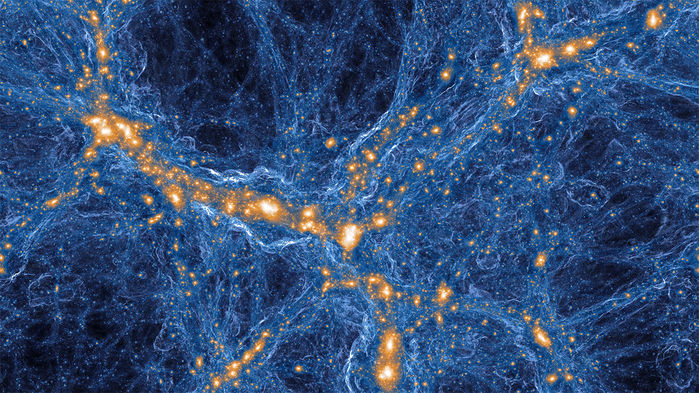
The Standard Model of Particle Physics (SM) has been tremendously successful in describing how the known particles interact with one another, whether it be how charged particles interact or how the fundamental particles obtain mass. Despite its successes, there are still a number of phenomena that have yet to be explained within the SM, including the nature of dark matter, dark energy, gravity, neutrino masses, etc. In our new paper, An Emergent Solution to the Strong CP Problem, we discuss a solution to the strong CP problem, which is not addressed by the SM itself, while additionally providing a theory for the properties of dark matter particles.
Dark Matter
In the 1960’s, astronomer Vera Rubin discovered a curious inconsistency in our understanding of galaxies. She observed that galaxies were rotating far too quickly to be held together. The amount of mass in the galaxy (and therefore the gravitational pull) seemed to be much less than would be needed to keep the stars in the outer parts of the galaxy in orbit. So what could be going on here? There must be some extra dark matter in the galaxy that we cannot see with our telescopes; matter that does not emit, reflect, or absorb light, but interacts gravitationally, and resultantly increases the overall gravitational pull of the galaxies. How much dark matter is there? In terms of mass, there is about five times more dark matter than normal matter. Although this may seem like a strange conclusion to jump to, there has been a myriad of other evidence that supports the existence of dark matter, such as galaxy formation, the features in the cosmic microwave background, the bending of light around dark matter, etc.
So where is all of the dark matter? Dark matter is everywhere, but it barely interacts with normal matter, so we haven’t been able to sense its presence directly, though we can observe its gravitational effects. Physicists have been trying to detect dark matter and to learn what it’s composed of on the microscopic level, but so far there hasn’t been any detection. Many believe dark matter is composed of particles, but there is a huge number of possibilities for what its properties are, so how do we know where to start looking? Often times, there are other mysteries in the SM that need to be addressed, and sometimes proposed solutions to those mysteries naturally explain dark matter as well.
What is the Strong CP Problem?
There are many different parameters in the SM and each of them has an effect of the physical properties of the particles, depending on what their value is. For example, the electric charge of the electron gives the strength of the electromagnetic force, which (among other things) is responsible for binding electrons with protons to create atoms. The specific parameter we’re interested in for this research is called θQCD. This enters in the equations for the strong force (the force that binds quarks together to make protons and neutrons). The value θQCD affects a property of the neutron called its electric dipole moment (EDM). From theory, we expect that the value of θQCD is close to 1, which means the neutron would have a large EDM. Yet, experimental measurements of the neutron EDM have determined that it either does not have one or it is much, much smaller than expected. So in short, the Strong CP problem is: Why is the neutron EDM much smaller than what we’d naturally expect?
The Axion Solution
Often times when particle physicists need to solve a particular problem or explain some phenomenon, they introduce new particles that have not been observed before. The most popular solution to this problem is to introduce a new particle called the axion. This axion particle has the particular property that it affects the neutron EDM in the exact same way as the θQCD parameter does, but with the opposite sign, meaning that their effects cancel out, leaving the neutron without an EDM. So, by virtue of this axion existing, the strong CP problem is solved, explaining why the neutron doesn’t have an EDM. Additionally, physicists have found that if the axion exists, it has the correct properties to be dark matter. So, this solution could address two phenomena that the SM does not.
An Emergent Solution?
In our paper, we propose a new solution that has a different philosophy than the axion case. Instead, we start with the fact that we know dark matter is a large component of the matter content of the universe. We then suggest that the dark matter is a massive vector boson (meaning it’s like a photon with mass), and that it behaves in such a way that it also eliminates the neutron EDM, but only if there’s a sufficient amount of dark matter around (in contrast to the axion theory, where the neutron doesn’t have an EDM anywhere in the universe). Thus, we may only measure the neutron to not have an EDM on Earth because there’s a lot of dark matter around. But in regions of the universe where there isn’t as much dark matter, the neutron may have an EDM and this creates potentially observable consequences, such as a change in the spectra of stars. Thus it is called an emergent solution because it comes as a consequence of the environment of dark matter surrounding the neutron. This is the first paper on this new idea, and we plan on exploring more implications of this theory in the future.
Post by Jason Arakawa, graduate student working on his PhD in Particle Theory at UCI.